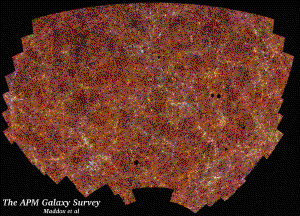Blog
Even Steven
5 January 2014
 Maddox, et al
Maddox, et alOne of the assumptions of cosmology is that at sufficiently large scales the universe is essentially the same everywhere (in formal terms, homogeneous and isotropic). The basic argument in favor of this cosmological principle is that if the laws of physics are the same everywhere (and we have good evidence that they are) then the way the universe appears is basically the same everywhere. Assuming it’s true, it means that the universe as seen from our vantage point on Earth is not biased in some way. This is important if we are to have confidence that our understanding of the universe is an accurate representation of how the universe really is.
Although the idea was considered at least as far back as the ancient Greeks, it was formally stated by Isaac Newton in his Principia, where he proposed that gravity was universal, meaning that it applied everywhere in the universe. This was a distinct break from the medieval worldview, which presumed the Earth was at the center of the universe. Of course when Newton proposed the idea, there wasn’t a lot of evidence to support him. Newton demonstrated that universal gravity worked for the motions of the planets in the solar system, but that’s not the same as assuming our view of the universe is pretty typical.
In the 1900s we began to get observational evidence that the cosmological principle is valid. We found that our Sun was part of a galaxy, but our galaxy was just one of many. The distribution of these galaxies looked somewhat uniform. In 1964 Penzias and Wilson measured the cosmic microwave background. This thermal remnant of the big bang has a very uniform temperature, with only small fluctuations, just as we would expect from the cosmological principle.
In recent decades we’ve been able to map the distribution of galaxies in the universe. For example, the APM galaxy survey done in the 1990s, which led to the image below of more than 2 million galaxies in a patch of sky. The small dark circles are regions that were excluded because a local bright star was in the way, but the rest of the region shows a uniform distribution of galaxies. At smaller scales there is a degree of clumping, but on large scales the distribution averages out.
Since then there have been even larger galaxy surveys, such as the 2dF Galaxy Redshift Survey and the Sloan Digital Sky Survey, and these show a similar result. From the laws of physics, to the cosmic background, to the distribution of galaxies, it really does appear that the universe is homogenous and isotropic.
As far as we can tell, the universe is even steven.